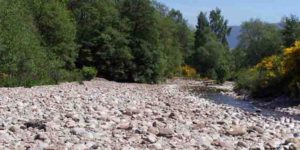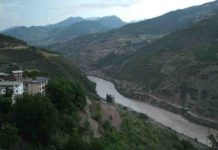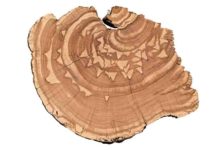
Pop the top off a can of mixed nuts and, chances are, Brazil nuts will be at the top. This phenomenon, of large particles tending to rise to the top of mixtures while small particles tend to sink down, is popularly known as the “Brazil nut effect” and more technically as granular segregation.
Look down at the top of a riverbed and it’s easy to draw a parallel: the top of a riverbed is typically lined with larger cobbles, while finer sand and small gravel particles make up the deeper layers.
Physicists concerned with particle movement have given a lot of thought to the mechanics by which particles sort in these types of scenarios, but that research has not been translated to earth science until now. In a new study, geophysicists from the University of Pennsylvania found that granular segregation helps explain the tendency of riverbeds to be lined by, or “armored” with, a layer of relatively larger particles.
Published in the journal Nature Communications, the findings enhance understanding of how riverbeds form, with implications for how rivers may also erode. But the research also makes new insights into the fundamental physics of particle segregation, which apply to all sorts of granular materials, from riverbeds and soils to industrial and pharmaceutical substances.
“There has been this granular segregation phenomenon that has been studied for decades,” said Douglas J. Jerolmack, associate professor in the Department of Earth and Environmental Science in Penn’s School of Arts and Sciences, “and then there’s this separate explanation by geologists and engineers about why riverbeds get a coarse layer on the surface, and the two had never met before. Our major contribution here is really taking the granular physics understanding of the segregation of particles — how big particles segregate and move up to the surface — and introducing it to the river problem.”
Jerolmack collaborated on the work with postdoctoral researchers Behrooz Ferdowsi, now at Princeton University; Carlos P. Ortiz, now at Deloitte Consulting; and Morgane Houssais, now at the City University of New York. Riverbed armoring is seen almost universally and is understood to be a way that rivers prevent excessive erosion.
“We call this armoring because the larger particles are like an armor that protects the riverbed underneath from getting eroded,” Jerolmack said. “If there are big cobbles that are lining the riverbed, then I’ll need a big flood in order to move them.”
Geologists have generally thought that fluid mechanics controls this pattern. The river water would wash away the finer particles, leaving the larger particles behind.
But the Penn-led team recognized that this explanation failed to conceive of the riverbed as a granular system, which would also be subject to the Brazil nut effect, not just the shear force of water.
To see if granular segregation did apply in a fluid system, the researchers turned to a laboratory stand-in for a river: a doughnut-shaped channel filled with large and small spherical particles. The lid of the channel pushes the fluid atop the particles, replicating the flow of a river.
As they had shown in an earlier study, particles move along the riverbed by two mechanisms: those at the top are pushed by the flow of liquid, while those deeper down creep along slowly due to the interaction among particles.
In the new work, the Penn team wanted to understand how these particles moved not just horizontally but also vertically in the bed.
Using their custom-built channel and fluid embedded with a fluorescent dye, Jerolmack and colleagues were able to scan through the entire depth of the channel and visualize the entire plane of particles, even those buried under several dozen other particles.
“It’s almost like taking an X-ray of our granular sample but with a laser and photographs,” Jerolmack said.
With the help of a software program, they were able to then track the horizontal and vertical positions of all of these particles through time. And they saw the Brazil nut effect in action.
“In this laboratory experiment of a very simplified river,” Jerolmack said, “we saw that, when we have a liquid pushing grains on the riverbed, those grains push grains underneath them that push grains that are underneath them and so on, and it creates this jostling motion that allows large particles to kind of float up. So we confirmed that this general behavior that is seen in granular systems seems to also occur in rivers.”
Another major finding, confirmed by computer simulations that account for the friction felt by each particle in the riverbed, was that this segregation of particles by size played out in two stages. In the first, the larger particles near the surface of the riverbed moved up, while those packed in the deeper parts of the bed appeared to remain almost motionless. But in a second stage, these creeping, deeper grains began to sort, the large ones occasionally getting sucked up into the faster flowing particles toward the top of the river bed and jostling upward.
“Basically no one had gone looking to see if exceedingly slow-moving granular materials contributed to segregation,” Jerolmack said. “The observation that we did see segregation happening, that coarse particles were moving up from this creeping layer, is brand new to science and also has all sorts of implications. It might explain how we see segregation happening in slow-moving places like soils on a hillside, where we tend to find coarse particles at the surface, despite there being no fluid force moving over them.”
Researchers have found it difficult to predict when rivers erode, or when hillsides dissolve into landslides, and these findings may help explain why these predictions have proved so elusive.
“We’ve been working on these problems for 100 years, and we still can’t predict with much certainty what fluid force is going to cause grains to start eroding,” Jerolmack said. “And that point changes through time. River-engineering projects, bridges and buildings all rely on estimates of the erosion threshold. I think we need to start from scratch with a new framework that incorporates granular physics.”
While these experiments and simulations can’t provide an exact replication for the complex conditions seen in rivers, such as turbulence, Jerolmack notes that the findings point to a need for integrating earth science with fundamental physics research to advance knowledge in both spheres.
“Our inability to predict when erosion will occur, our inability to predict when a slow, oozing pile of dirt on a hill will suddenly become a landslide, is because we are up against our limit of the fundamental understanding of how disordered materials behave,” Jerolmack said. “We need to advance our understanding of fundamental physics of disordered materials in order to have any shot at making predictions in the earth-materials realm. And this is one problem where I think we’ve made a start at doing that.
“Penn is an ideal place to do this,” he said. “Here there are a large number of physicists and engineers with a broad and interdisciplinary view of materials science. Collaborations facilitated by the Materials Research Science and Engineering Center have made this kind of work possible.”
The study was supported by the United States Army Research Office (Grant 64455EV) and National Science Foundation (grants EAR-1224943, EAR-1344280 and DMR-1120901).
Reference:
Behrooz Ferdowsi, Carlos P. Ortiz, Morgane Houssais, Douglas J. Jerolmack. River-bed armouring as a granular segregation phenomenon. Nature Communications, 2017; 8 (1) DOI: 10.1038/s41467-017-01681-3
Note: The above post is reprinted from materials provided by University of Pennsylvania.










